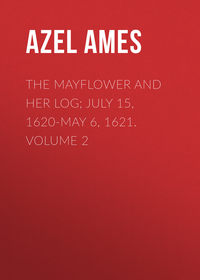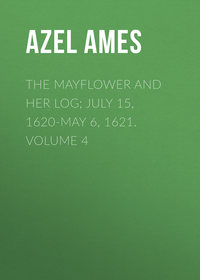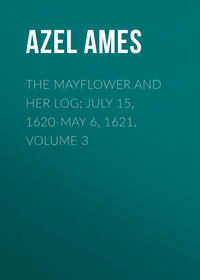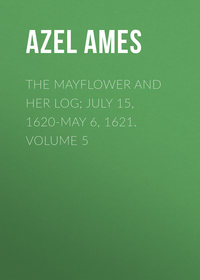 полная версия
полная версияThe Mayflower and Her Log; July 15, 1620-May 6, 1621. Volume 1

Azel Ames
The Mayflower and Her Log; July 15, 1620-May 6, 1621 – Volume 1
"Next to the fugitives whom Moses led out of Egypt, the little shipload of outcasts who landed at Plymouth are destined to influence the future of the world."
JAMES RUSSELL LOWELLINTRODUCTORY
O civilized humanity, world-wide, and especially to the descendants of the Pilgrims who, in 1620, laid on New England shores the foundations of that civil and religious freedom upon which has been built a refuge for the oppressed of every land, the story of the Pilgrim "Exodus" has an ever-increasing value and zest. The little we know of the inception, development, and vicissitudes of their bold scheme of colonization in the American wilderness only serves to sharpen the appetite for more.
Every detail and circumstance which relates to their preparations; to the ships which carried them; to the personnel of the Merchant Adventurers associated with them, and to that of the colonists themselves; to what befell them; to their final embarkation on their lone ship,—the immortal MAY-FLOWER; and to the voyage itself and to its issues, is vested to-day with, a supreme interest, and over them all rests a glamour peculiarly their own.
For every grain of added knowledge that can be gleaned concerning the Pilgrim sires from any field, their children are ever grateful, and whoever can add a well-attested line to their all-too-meagre annals is regarded by them, indeed by all, a benefactor.
Of those all-important factors in the chronicles of the "Exodus,"—the Pilgrim ships, of which the MAY-FLOWER alone crossed the seas,—and of the voyage itself, there is still but far too little known. Of even this little, the larger part has not hitherto been readily accessible, or in form available for ready reference to the many who eagerly seize upon every crumb of new-found data concerning these pious and intrepid Argonauts.
To such there can be no need to recite here the principal and familiar facts of the organization of the English "Separatist" congregation under John Robinson; of its emigration to Holland under persecution of the Bishops; of its residence and unique history at Leyden; of the broad outlook of its members upon the future, and their resultant determination to cross the sea to secure larger life and liberty; and of their initial labors to that end. We find these Leyden Pilgrims in the early summer of 1620, their plans fairly matured and their agreements between themselves and with their merchant associates practically concluded, urging forward their preparations for departure; impatient of the delays and disappointments which befell, and anxiously seeking shipping for their long and hazardous voyage.
It is to what concerns their ships, and especially that one which has passed into history as "the Pilgrim bark," the MAY-FLOWER, and to her pregnant voyage, that the succeeding chapters chiefly relate. In them the effort has been made to bring together in sequential relation, from many and widely scattered sources, everything germane that diligent and faithful research could discover, or the careful study and re-analysis of known data determine. No new and relevant item of fact discovered, however trivial in itself, has failed of mention, if it might serve to correct, to better interpret, or to amplify the scanty though priceless records left us, of conditions, circumstances, and events which have meant so much to the world.
As properly antecedent to the story of the voyage of the MAY-FLOWER as told by her putative "Log," albeit written up long after her boned lay bleaching on some unknown shore, some pertinent account has been given of the ship herself and of her "consort," the SPEEDWELL; of the difficulties attendant on securing them; of the preparations for the voyage; of the Merchant Adventurers who had large share in sending them to sea; of their officers and crews; of their passengers and lading; of the troubles that assailed before they had "shaken off the land," and of the final consolidation of the passengers and lading of both ships upon the MAY- FLOWER, for the belated ocean passage. The wholly negative results of careful search render it altogether probable that the original journal or "Log" of the MAY-FLOWER (a misnomer lately applied by the British press, and unhappily continued in that of the United States, to the recovered original manuscript of Bradford's "History of Plimoth Plantation "), if such journal ever existed, is now hopelessly lost.
So far as known, no previous effort has been made to bring together in the consecutive relation of such a journal, duly attested and in their entirety, the ascertained daily happenings of that destiny-freighted voyage. Hence, this later volume may perhaps rightly claim to present— and in part to be, though necessarily imperfect—the sole and a true "Log of the MAY-FLOWER." No effort has been made, however, to reduce the collated data to the shape and style of the ship's "Log" of recent times, whose matter and form are largely prescribed by maritime law. While it is not possible to give, as the original—if it existed—would have done, the results of the navigators' observations day by day; the "Lat." and "Long."; the variations of the wind and of the magnetic needle; the tallies of the "lead" and "log" lines; "the daily run," etc.—in all else the record may confidently be assumed to vary little from that presumably kept, in some form, by Captain Jones, the competent Master of the Pilgrim bark, and his mates, Masters Clarke and Coppin.
As the charter was for the "round voyage," all the features and incidents of that voyage until complete, whether at sea or in port, properly find entry in its journal, and are therefore included in this compilation, which it is hoped may hence prove of reference value to such as take interest in Pilgrim studies. Although the least pleasant to the author, not the least valuable feature of the work to the reader—especially if student or writer of Pilgrim history—will be found, it is believed, in the numerous corrections of previously published errors which it contains, some of which are radical and of much historical importance. It is true that new facts and items of information which have been coming to light, in long neglected or newly discovered documents, etc., are correctives of earlier and natural misconceptions, and a certain percentage of error is inevitable, but many radical and reckless errors have been made in Pilgrim history which due study and care must have prevented. Such errors have so great and rapidly extending power for harm, and, when built upon, so certainly bring the superstructure tumbling to the ground, that the competent and careful workman can render no better service than to point out and correct them wherever found, undeterred by the association of great names, or the consciousness of his own liability to blunder. A sound and conscientious writer will welcome the courteous correction of his error, in the interest of historical accuracy; the opinion of any other need not be regarded.
Some of the new contributions (or original demonstrations), of more or less historical importance, made to the history of the Pilgrims, as the author believes, by this volume, are as follows:—
(a) A closely approximate list of the passengers who left Delfshaven on the SPEEDWELL for Southampton; in other words, the names—those of Carver and Cushman and of the latter's family being added—of the Leyden contingent of the MAY-FLOWER Pilgrims.
(b) A closely approximate list of the passengers who left London in the MAY-FLOWER for Southampton; in other words, the names (with the deduction of Cushman and family, of Carver, who was at Southampton, and of an unknown few who abandoned the voyage at Plymouth) of the English contingent of the MAY-FLOWER Pilgrims.
(c) The establishment as correct, beyond reasonable doubt, of the date, Sunday, June 11/21, 1620, affixed by Robert Cushman to his letter to the Leyden leaders (announcing the "turning of the tide" in Pilgrim affairs, the hiring of the "pilott" Clarke, etc.), contrary to the conclusions of Prince, Arber, and others, that the letter could not have been written on Sunday.
(d) The demonstration of the fact that on Saturday, June 10/20, 1620, Cushman's efforts alone apparently turned the tide in Pilgrim affairs; brought Weston to renewed and decisive cooperation; secured the employment of a "pilot," and definite action toward hiring a ship, marking it as one of the most notable and important of Pilgrim "red- letter days."
(e) The demonstration of the fact that the ship of which Weston and Cushman took "the refusal," on Saturday, June 10/20, 1620, was not the MAY-FLOWER, as Young, Deane, Goodwin, and other historians allege.
(f) The demonstration of the fact (overthrowing the author's own earlier views) that the estimates and criticisms of Robinson, Carver, Brown, Goodwin, and others upon Robert Cushman were unwarranted, unjust, and cruel, and that he was, in fact, second to none in efficient service to the Pilgrims; and hence so ranks in title to grateful appreciation and memory.
(g) The demonstration of the fact that the MAY-FLOWER was not chartered later than June 19/29, 1620, and was probably chartered in the week of June 12/22—June 19/29 of that year.
(h) The addition of several new names to the list of the Merchant Adventurers, hitherto unpublished as such, with considerable new data concerning the list in general.
(i) The demonstration of the fact that Martin and Mullens, of the MAY- FLOWER colonists, were also Merchant Adventurers, while William White was probably such.
(j) The demonstration of the fact that "Master Williamson," the much- mooted incognito of Bradford's "Mourt's Relation" (whose existence even has often been denied by Pilgrim writers), was none other than the "ship's-merchant," or "purser" of the MAY-FLOWER,—hitherto unknown as one of her officers, and historically wholly unidentified.
(k) The general description of; and many particulars concerning, the MAY- FLOWER herself; her accommodations (especially as to her cabins), her crew, etc., hitherto unknown.
(1) The demonstration of the fact that the witnesses to the nuncupative will of William Mullens were two of the MAY-FLOWER'S crew (one being possibly the ship's surgeon), thus furnishing the names of two more of the ship's company, and the only names—except those of her chief officers—ever ascertained.
(m) The indication of the strong probability that the entire company of the Merchant Adventurers signed, on the one part, the charter-party of the MAY-FLOWER.
(n) An (approximate) list of the ages of the MAY-FLOWER'S passengers and the respective occupations of the adults.
(o) The demonstration of the fact that no less than five of the Merchant Adventurers cast in their lots and lives with the Plymouth Pilgrims as colonists.
(p) The indication of the strong probability that Thomas Goffe, Esquire, one of the Merchant Adventurers, owned the "MAY-FLOWER" when she was chartered for the Pilgrim voyage,—as also on her voyages to New England in 1629 and 1630.
(q) The demonstration of the fact that the Master of the MAY-FLOWER was Thomas Jones, and that there was an intrigue with Master Jones to land the Pilgrims at some point north of the 41st parallel of north latitude, the other parties to which were, not the Dutch, as heretofore claimed, but none other than Sir Ferdinando Gorges and the Earl of Warwick, chiefs of the "Council for New England," in furtherance of a successful scheme of Gorges to steal the Pilgrim colony from the London Virginia Company, for the more "northern Plantations" of the conspirators.
(r) The demonstration of the fact that a second attempt at stealing the colony—by which John Pierce, one of the Adventurers, endeavored to possess himself of the demesne and rights of the colonists, and to make them his tenants—was defeated only by the intervention of the "Council" and the Crown, the matter being finally settled by compromise and the transfer of the patent by Pierce (hitherto questioned) to the colony.
(s) The demonstration of the actual relations of the Merchant Adventurers and the Pilgrim colonists—their respective bodies being associated as but two partners in an equal copartnership, the interests of the respective partners being (probably) held upon differing bases—contrary to the commonly published and accepted view.
(t) The demonstration of the fact that the MAY-FLOWER—contrary to the popular impression—did not enter Plymouth harbor, as a "lone vessel," slowly "feeling her way" by chart and lead-line, but was undoubtedly piloted to her anchorage—previously "sounded" for her—by the Pilgrim shallop, which doubtless accompanied her from Cape Cod harbor, on both her efforts to make this haven, under her own sails.
(u) The indication of the strong probability that Thomas English was helmsman of the MAY-FLOWER'S shallop (and so savior of her sovereign company, at the entrance of Plymouth harbor on the stormy night of the landing on Clarke's Island), and that hence to him the salvation of the Pilgrim colony is probably due; and
(v) Many facts not hitherto published, or generally known, as to the antecedents, relationships, etc., of individual Pilgrims of both the Leyden and the English contingents, and of certain of the Merchant Adventurers.
For convenience' sake, both the Old Style and the New Style dates of many events are annexed to their mention, and double-dating is followed throughout the narrative journal or "Log" of the Pilgrim ship.
As the Gregorian and other corrections of the calendar are now generally well understood, and have been so often stated in detail in print, it is thought sufficient to note here their concrete results as affecting dates occurring in Pilgrim and later literature.
From 1582 to 1700 the difference between O.S. and N.S. was ten (10) days (the leap-year being passed in 1600). From 1700 to 1800 it was eleven (11) days, because 1700 in O.S. was leap-year. From 1800 to 1900 the difference is twelve (12) days, and from 1900 to 2000 it will be thirteen (13) days. All the Dutch dates were New Style, while English dates were yet of the Old Style.
There are three editions of Bradford's "History of Plimoth Plantation" referred to herein; each duly specified, as occasion requires. (There is, beside, a magnificent edition in photo-facsimile.) They are:—
(a) The original manuscript itself, now in possession of the State of Massachusetts, having been returned from England in 1897, called herein "orig. MS."
(b) The Deane Edition (so-called) of 1856, being that edited by the late Charles Deane for the Massachusetts Historical Society and published in "Massachusetts Historical Collections," vol. iii.; called herein "Deane's ed."
(c) The Edition recently published by the Commonwealth of Massachusetts, and designated as the "Mass. ed."
Of "Mourt's Relation" there are several editions, but the one usually referred to herein is that edited by Rev. Henry M. Dexter, D. D., by far the best. Where reference is made to any other edition, it is indicated, and "Dexter's ed." is sometimes named.
AZEL AMES.
WAKEFIELD, MASSACHUSETTS,
March 1, 1901.
"Hail to thee, poor little ship MAY-FLOWER—of Delft Haven— poor, common-looking ship, hired by common charter-party for coined dollars,—caulked with mere oakum and tar, provisioned with vulgarest biscuit and bacon,—yet what ship Argo or miraculous epic ship, built by the sea gods, was other than a foolish bumbarge in comparison!"
THOMAS CARLYLECHAPTER I
THE NAME—"MAY-FLOWER"
"Curiously enough," observes Professor Arber, "these names [MAY-FLOWER and "SPEEDWELL] do not occur either in the Bradford manuscript or in 'Mourt's Relation.'"
[A Relation, or Journal, of the Beginning and Proceedings of the English Plantation settled at Plymouth in New England, etc. G. Mourt, London, 1622. Undoubtedly the joint product of Bradford and Winslow, and sent to George Morton at London for publication. Bradford says (op, cit. p. 120): "Many other smaler maters I omite, sundrie of them having been already published, in a Jurnall made by one of ye company," etc. From this it would appear that Mourt's Relation was his work, which it doubtless principally was, though Winslow performed an honorable part, as "Mourt's" introduction and other data prove.]
He might have truthfully added that they nowhere appear in any of the letters of the "exodus" period, whether from Carver, Robinson, Cushman, or Weston; or in the later publications of Window; or in fact of any contemporaneous writer. It is not strange, therefore, that the Rev. Mr. Blaxland, the able author of the "Mayflower Essays," should have asked for the authority for the names assigned to the two Pilgrim ships of 1620.
It seems to be the fact, as noted by Arber, that the earliest authentic evidence that the bark which bore the Pilgrims across the North Atlantic in the late autumn of 1620 was the MAY-FLOWER, is the "heading" of the "Allotment of Lands"—happily an "official" document—made at New Plymouth, New England, in March, 1623—It is not a little remarkable that, with the constantly recurring references to "the ship,"—the all- important factor in Pilgrim history,—her name should nowhere have found mention in the earliest Pilgrim literature. Bradford uses the terms, the "biger ship," or the "larger ship," and Winslow, Cushman, Captain John Smith, and others mention simply the "vessel," or the "ship," when speaking of the MAY-FLOWER, but in no case give her a name.
It is somewhat startling to find so thorough-paced an Englishman as Thomas Carlyle calling her the MAY-FLOWER "of Delft-Haven," as in the quotation from him on a preceding page. That he knew better cannot be doubted, and it must be accounted one of those 'lapsus calami' readily forgiven to genius,—proverbially indifferent to detail.
Sir Ferdinando Gorges makes the curious misstatement that the Pilgrims had three ships, and says of them: "Of the three ships (such as their weak fortunes were able to provide), whereof two proved unserviceable and so were left behind, the third with great difficulty reached the coast of New England," etc.
CHAPTER II
THE MAY-FLOWER'S CONSORT THE SPEEDWELL
The SPEEDWELL was the first vessel procured by the Leyden Pilgrims for the emigration, and was bought by themselves; as she was the ship of their historic embarkation at Delfshaven, and that which carried the originators of the enterprise to Southampton, to join the MAY-FLOWER,– whose consort she was to be; and as she became a determining factor in the latter's belated departure for New England, she may justly claim mention here as indeed an inseparable "part and parcel" of the May- FLOWER'S voyage.
The name of this vessel of associate historic renown with the MAY-FLOWER was even longer in finding record in the early literature of the Pilgrim hegira than that of the larger It first appeared, so far as discovered, in 1669—nearly fifty years after her memorable service to the Pilgrims on the fifth page of Nathaniel Morton's "New England's Memorial."
Davis, in his "Ancient Landmarks of Plymouth," makes a singular error for so competent a writer, when he says: "The agents of the company in England had hired the SPEEDWELL, of sixty tons, and sent her to Delfthaven, to convey the colonists to Southampton." In this, however, he but follows Mather and the "Modern Universal History," though both are notably unreliable; but he lacks their excuse, for they were without his access to Bradford's "Historie." That the consort-pinnace was neither "hired" nor "sent to Delfthaven" duly appears.
Bradford states the fact,—that "a smale ship (of some 60 tune), was bought and fitted in Holand, which was intended to serve to help to transport them, so to stay in ye countrie and atend ye fishing and such other affairs as might be for ye good and benefite of ye colonie when they come ther." The statements of Bradford and others indicate that she was bought and refitted with moneys raised in Holland, but it is not easy to understand the transaction, in view of the understood terms of the business compact between the Adventurers and the Planters, as hereinafter outlined. The Merchant Adventurers—who were organized (but not incorporated) chiefly through the activity of Thomas Weston, a merchant of London, to "finance" the Pilgrim undertaking—were bound, as part of their engagement, to provide the necessary shipping,' etc., for the voyage. The "joint-stock or partnership," as it was called in the agreement of the Adventurers and Planters, was an equal partnership between but two parties, the Adventurers, as a body, being one of the co-partners; the Planter colonists, as a body, the other. It was a partnership to run for seven years, to whose capital stock the first- named partner (the Adventurers) was bound to contribute whatever moneys, or their equivalents,—some subscriptions were paid in goods,—were necessary to transport, equip, and maintain the colony and provide it the means of traffic, etc., for the term named. The second-named partner (the Planter body) was to furnish the men, women, and children,—the colonists themselves, and their best endeavors, essential to the enterprise,—and such further contributions of money or provisions, on an agreed basis, as might be practicable for them. At the expiration of the seven years, all properties of every kind were to be divided into two equal parts, of which the Adventurers were to take one and the Planters the other, in full satisfaction of their respective investments and claims. The Adventurers' half would of course be divided among themselves, in such proportion as their individual contributions bore to the sum total invested. The Planters would divide their half among their number, according to their respective contributions of persons, money, or provisions, as per the agreed basis, which was:
[Bradford's Historie, Deane's ed.; Arber, op. cit. p. 305. The fact that Lyford (Bradford, Historie, Mass. ed. p. 217) recommended that every "particular" (i.e. non-partnership colonist) sent out by the Adventurers—and they had come to be mostly of that class—"should come over as an Adventurer, even if only a ser vant," and the fact that he recognized that some one would have to pay in L10 to make each one an Adventurer, would seem to indicate that any one was eligible and that either L10 was the price of the Merchant Adventurer's share, or that this was the smallest subscription which would admit to membership. Such "particular," even although an Adventurer, had no partnership share in the Planters' half-interest; had no voice in the government, and no claim for maintenance. He was, however, amenable to the government, subject to military duty and to tax. The advantage of being an Adventurer without a voice in colony affairs would be purely a moral one.]
that every person joining the enterprise, whether man, woman, youth, maid, or servant, if sixteen years old, should count as a share; that a share should be reckoned at L10, and hence that L10 worth of money or provisions should also count as a share. Every man, therefore, would be entitled to one share for each person (if sixteen years of age) he contributed, and for each L10 of money or provisions he added thereto, another share. Two children between ten and sixteen would count as one and be allowed a share in the division, but children under ten were to have only fifty acres of wild land. The scheme was admirable for its equity, simplicity, and elasticity, and was equally so for either capitalist or colonist.
Goodwin notes, that, "in an edition of Cushman's 'Discourse,' Judge Davis of Boston advanced the idea that at first the Pilgrims put all their possessions into a common stock, and until 1623 had no individual property. In his edition of Morton's 'Memorial' he honorably admits his error." The same mistake was made by Robertson and Chief Justice Marshall, and is occasionally repeated in this day. "There was no community of goods, though there was labor in common, with public supplies of food and clothing." Neither is there warrant for the conclusion of Goodwin, that because the holdings of the Planters' half interest in the undertaking were divided into L10 shares, those of the Adventurers were also. It is not impossible, but it does not necessarily follow, and certain known facts indicate the contrary.








